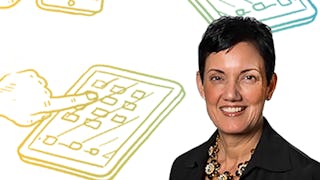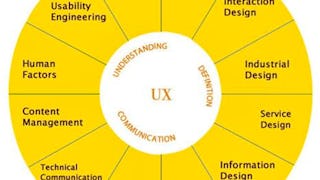Start the UX Design Process: Empathize, Define, Ideate is the second course in a certificate program that will equip you with the skills needed to apply to entry-level jobs in user experience (UX) design. In this course, you’ll complete the first phases of the design process for a project that you’ll be able to include in your portfolio. You will learn how to empathize with users and understand their pain points, define user needs using problem statements, and come up with lots of ideas for solutions to those user problems.

Enjoy unlimited growth with a year of Coursera Plus for $199 (regularly $399). Save now.

Start the UX Design Process: Empathize, Define, and Ideate
This course is part of Google UX Design Professional Certificate

Instructor: Google Career Certificates
642,660 already enrolled
Included with
(16,737 reviews)
What you'll learn
Empathize with users to understand their needs and pain points.
Develop problem statements to define user needs.
Generate ideas for possible solutions to user problems.
Skills you'll gain
Details to know

Add to your LinkedIn profile
See how employees at top companies are mastering in-demand skills

Build your Design and Product expertise
- Learn new concepts from industry experts
- Gain a foundational understanding of a subject or tool
- Develop job-relevant skills with hands-on projects
- Earn a shareable career certificate from Google

There are 4 modules in this course
Get ready to begin the design process for a new portfolio project: a mobile app! This part of the course will focus on empathizing with users, which is the first phase of the design process. You’ll think through the needs of your potential users to build empathy maps and create personas. These hands-on activities will help you understand user perspectives and pain points.
What's included
9 videos11 readings2 assignments1 plugin
In this part of the course, you'll continue to empathize with users of the mobile app you'll later design. You'll craft user stories and develop user journey maps. You’ll also learn about the importance of considering accessibility when empathizing with users.
What's included
8 videos5 readings1 assignment1 plugin
All of your work to empathize with users will help you define the problem that users are facing. In this part of the course, you'll move from the empathize phase into the define phase of the design process. To define the problem your designs will solve, you’ll build a problem statement, a hypothesis statement, and a value proposition. In addition, you’ll explore how psychology and human factors influence design.
What's included
7 videos7 readings3 assignments
You're ready to move into the third phase of the design process: ideate. You'll consider everything you've learned about the users you're designing for and the problems they're facing in order to brainstorm ideas for design solutions. To help you come up with lots of ideas for design solutions, you’ll conduct a competitive audit and complete design activities, like How Might We and Crazy Eights.
What's included
16 videos19 readings7 assignments
Earn a career certificate
Add this credential to your LinkedIn profile, resume, or CV. Share it on social media and in your performance review.
Instructor

Offered by
Explore more from Design and Product
 Status: Preview
Status: PreviewGeorgia Institute of Technology
 Status: Free Trial
Status: Free Trial Status: Free Trial
Status: Free Trial
Why people choose Coursera for their career




Learner reviews
16,737 reviews
- 5 stars
84.69%
- 4 stars
12.60%
- 3 stars
1.89%
- 2 stars
0.38%
- 1 star
0.41%
Showing 3 of 16737
Reviewed on May 24, 2022
Excellent course and the instructor is amazing! Definitly recommanded for people who want to learn more about design research, ux process and get a more professionnal perception in user experience.
Reviewed on Sep 17, 2022
It's an awesome course being a self-taught designer i can gather lot of information from this course. How to do research fpr your product, interaction with users and focus on User-pain points.
Reviewed on Apr 26, 2021
Course instructor was absolutely fantastic - and delivers the knowledge in such a succinct, charismatic way. The content is superb, and the assignments challenging. A very worthwhile course.

Open new doors with Coursera Plus
Unlimited access to 10,000+ world-class courses, hands-on projects, and job-ready certificate programs - all included in your subscription
Advance your career with an online degree
Earn a degree from world-class universities - 100% online
Join over 3,400 global companies that choose Coursera for Business
Upskill your employees to excel in the digital economy
Frequently asked questions
User experience (UX) designers focus on the experience that users have while using products like websites, apps, and physical objects. UX designers make those everyday interactions useful, enjoyable, and accessible. The role of an entry-level UX designer might include coming up with ideas to address user problems, conducting research with users, and designing wireframes, mockups, and prototypes.
If you enjoy talking to and empathizing with people, drawing, thinking creatively, or paying attention to details, a job as a UX designer might be a good fit for you!
This course is the second of seven courses that will equip you with the skills you need to apply to entry-level jobs in user experience design. We recommend that you complete the first course of the Google UX Design Certificate, Foundations of User Experience (UX) Design, before completing this second course of the program.
Otherwise, no prior experience with design or specific tools is required. All you need is an interest in creating great user experiences for apps, websites, and physical products!
Figma and Adobe XD are the design tools taught in the seven courses of the Google UX Design Certificate. This course focuses on the early phases of the design process, so both Figma and Adobe XD will be introduced in later courses of the program.
Spreadsheets, word processing applications, and presentation applications will also be used. Throughout the program, you will create a professional portfolio, using the platform of your choice, to showcase your UX design work.
More questions
Financial aid available,
¹ Some assignments in this course are AI-graded. For these assignments, your data will be used in accordance with Coursera's Privacy Notice.


